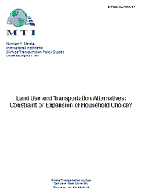- 408-924-7560
- mineta-institute@sjsu.edu
- Donate
Land Use and Transportation Alternatives: Constraint or Expansion of Household Choice
Transportation and land use research that considers such alternatives as New Urbanist development, jobs-housing balance, transit villages, or “smart growth” most typically tests the capacity of such physical forms to reduce vehicle miles traveled (VMT) or bring about other desired outcomes in the modification of travel behavior. Establishing such causality is broadly seen as a precondition for the urban planning interventions that are presumed to be necessary to bring these forms about. But such a view neglects the extent to which current interventions—notably zoning and transportation regulations—tend to preclude the development of such innovations in areas of high accessibility where they can potentially be of the greatest benefit.
Payoffs in VMT reduction, though desirable, are hardly the necessary precondition for the relaxation of such regulations. Instead, the increased land use and transportation choice that such liberalization can engender is self-justifying in that it allows households to forge a closer link between their land use and transportation preferences on the one hand and their actual choices on the other. This framework is examined here through a comparison of two metropolitan areas: Boston, which offers its residents relatively rich opportunities for residence in transit and pedestrian friendly areas, and Atlanta, which offers many fewer such opportunities. The study is based on three principal components: A clustering of neighborhoods throughout each metropolitan area according to their transit and pedestrian characteristics; an urban design analysis of selected neighborhoods in each region; and a survey of 1600 households regarding their preferences for neighborhood environments. The study concludes that while residents of Atlanta are considerably less interested in transit- and pedestrian friendly neighborhoods than their Boston counterparts, the difference in preference is insufficient to explain the difference in the transit- and pedestrian quality of the neighborhoods the two groups inhabit. The neighborhood choices of the Boston residents was, as a consequence, considerably more sensitive to their transportation and land use preferences than the choices of their Atlanta counterparts.
JONATHON LEVINE. PhD
Jonathan Levine, PhD is Associate Professor and Coordinator of Doctoral
Studies, Urban and Regional Planning Program, A. Alfred Taubman
College of Architecture and Urban Planning, University of Michigan.
-
Contact Us
San José State University One Washington Square, San Jose, CA 95192 Phone: 408-924-7560 Email: mineta-institute@sjsu.edu






